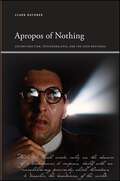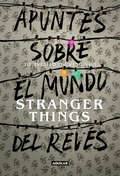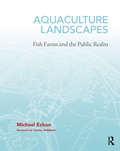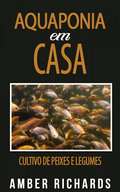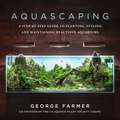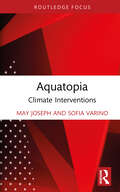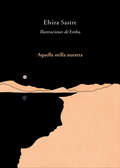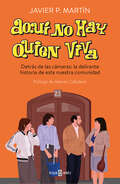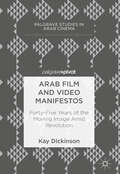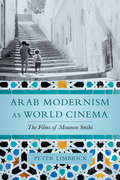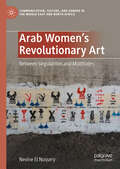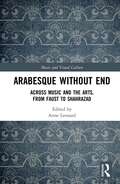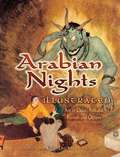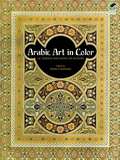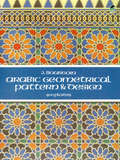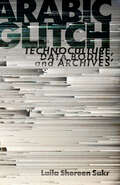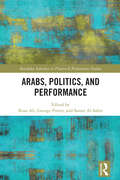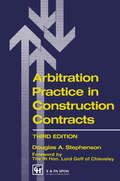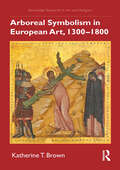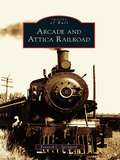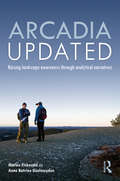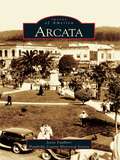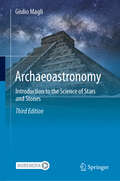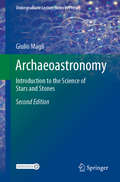- Table View
- List View
Apropos of Nothing: Deconstruction, Psychoanalysis, and the Coen Brothers (SUNY series, Insinuations: Philosophy, Psychoanalysis, Literature)
by Clark BucknerThe Coen Brothers' films are rife with figures of absence. In The Big Lebowski, the Dude does nothing. He is put on the trail of a kidnapping that never happened, and solves the crime when he realizes that he paid the ransom with "a ringer for a ringer." The Hudsucker Proxy features a dupe who draws zeros throughout the film, enthusiastically proclaiming, "You know, for the kids!" Barton Fink is a film that revolves around the absence of a film. In Apropos of Nothing, Clark Buckner appeals to these and other figures of the void in the Coen Brothers' films in order to articulate the close proximity and ultimate opposition between Lacanian psychoanalysis and Derridean deconstruction. In the process, he situates both theories in relationship to Heidegger's existential phenomenology, and undertakes a comparative analysis of the negativity in death, language, drive, anxiety, visual perception, paternity, and the unconscious. Formulating one of the most theoretically rigorous readings of the Coens' oeuvre to date, Buckner also offers a readable overview of some central debates in late twentieth-century continental philosophy.
Apuntes sobre el mundo del revés. Una guía no oficial de Stranger Things
by Adams GuyLa guía definitiva para desvelar todos los secretos de Stranger Things . Devoraste Stranger Things en menos de una semana y acabar de verla te ha dejado con un vacío del tamaño de un Demogorgon. No te preocupes, tiene solución: Apuntes sobre el mundo del revés es una guía para descubrirlo todo sobre los orígenes de la serie. Incluye una incomparable banda sonora de los 80 y un montón de hechos tenebrosos, además de test graciosos y curiosidades para que estés preparado para disfrutar al máximo de la próxima temporada. Si quieres saber cuál es la influencia que Steven Spielberg ha tenido en la serie, qué libros de Stephen King deberías leer (spoiler: casi todos) o de dónde ha salido el nombre de David O'Bannon (el policía que encuentra el cadáver de Will), este es el libro perfecto para ti. Haz acopio de Eggos y viaja a Hawkins, Indiana. ¡Y que no se te olviden las luces de Navidad!
Aquaculture Landscapes: Fish Farms and the Public Realm
by Michael EzbanAquaculture Landscapes explores the landscape architecture of farms, reefs, parks, and cities that are designed to entwine the lives of fish and humans. In the twenty-first century, aquaculture’s contribution to the supply of fish for human consumption exceeds that of wild-caught fish for the first time in history. Aquaculture has emerged as the fastest growing food production sector in the world, but aquaculture has agency beyond simply converting fish to food. Aquaculture Landscapes recovers aquaculture as a practice with a deep history of constructing extraordinary landscapes. These landscapes are characterized and enriched by multispecies interdependency, performative ecologies, collaborative practices, and aesthetic experiences between humans and fish. Aquaculture Landscapes presents over thirty contemporary and historical landscapes, spanning six continents, with incisive diagrams and vivid photographs. Within this expansive scope is a focus on urban aquaculture projects by leading designers—including Turenscape, James Corner Field Operations, and SCAPE—that employ mutually beneficial strategies for fish and humans to address urban coastal resiliency, wastewater management, and other contemporary urban challenges. Michael Ezban delivers a compelling account of the coalitions of fish and humans that shape the form, function, and identity of cities, and he offers a forward-thinking theorization of landscape as the preeminent medium for the design of ichthyological urbanism in the Anthropocene. With over two hundred evocative images, including ninety original drawings by the author, Aquaculture Landscapes is a richly illustrated portrayal of aquaculture seen through the disciplinary lens of landscape architecture. As the first book devoted to this topic, Aquaculture Landscapes is an original and essential resource for landscape architects, urbanists, animal geographers, aquaculturists, and all who seek and value multispecies cohabitation of a shared public realm.
Aquaponia em Casa
by João Campos Monteiro Amber RichardsDescrição do livro: Já alguma vez se perguntou o que é a aquaponia? Será que é viável para o espaço de que dispõe? Este livro dá-lhe uma visão geral desta técnica para o ajudar a responder a estas perguntas e muito mais. A aquaponia é a ciência revolucionária onde as plantas são cultivadas em água em vez de solo. Esta água é também utilizada no cultivo de peixes. Os resíduos produzidos pelos peixes ou outras criaturas aquáticas do viveiro fornecem nutrientes às plantas, que por sua vez purificam a água. A aquaponia, quando montada corretamente, pode ser autossustentável e ter um ambiente saudável para peixes e plantas. A aquaponia em casa é um guia para iniciantes deste hobby. Neste livro são-lhe dados os princípios básicos para esta forma maravilhosa e emocionante de cultivo. Nele encontrará informações sobre os componentes de que necessita e formas de construir o seu próprio sistema de aquaponia, que lhe fornece saudável peixe fresco e deliciosos legumes durante todo o ano. Faça o download da sua cópia agora.
Aquascaping: A Step-by-Step Guide to Planting, Styling, and Maintaining Beautiful Aquariums
by George FarmerLearn how to create and maintain your own underwater ecosystem. Aquascaping is the art of creating beautiful aquariums with natural materials and live plants. From the brilliance of Takashi Amano and numerous other innovators, aquascapes have become a popular way to enjoy aquariums. In Aquascaping: A Step-by-Step Guide to Planting, Styling, and Maintaining Beautiful Underwater Aquariums, planted aquarium expert George Farmer teaches how to create the perfect aquascape. Included in this book are full-color photographs that will supply readers with: Step-by-step instructions on setting up your tankDifferent styling suggestions that best suit your landscapeHow to pick plants, rocks, driftwood, substrate, and aquatic lifeUnderstanding the chemistry and biology involved in keeping a healthy aquariumMaintenance and upkeepAnd much more Creating an underwater ecosystem is not only a rewarding experience, but can bring much peace and relaxation to your life. So whether you&’re a novice aquarist or seasoned aquascaper, Aquascaping will teach you all the tricks of the trade so that your beautiful aquarium can be enjoyed by family, friends, and, most importantly, yourself.
Aquatopia: Climate Interventions (Critical Climate Studies)
by May Joseph Sofia VarinoAquatopia documents Harmattan Theater’s ecological interventions and traces its engagements with water-bound landscapes, colonial histories, climate change, and public space across New York City, Venice, Amsterdam, Lisbon, and Cochin. The volume uses Harmattan’s site-specific performances as a point of departure to consider climate change and rising sea levels as geographical, ecological, and urban phenomena. Instead of a collection of flat, static surfaces, the Aquatopia atlas is animated by a disorienting, anti-mapping strategy, producing a deterritorialized, nomadic, fluid atlas unfolding in real time as an archive of climate change in multidimensional, active space. The book is designed for pedagogical access, with interludes that consolidate the learning outcomes of the experimental theory animating each site-specific performance. Accompanied by close descriptions of five performances and supplemented by digital documentation available online, this volume intervenes in discussions on climate change, urbanism, and postcolonization/decolonialization, and contributes to interdisciplinary studies of ecology and environmental politics, postcolonial/decolonial theories and practices, performance studies and aesthetics, in particular public art, and performance as research.
Aquella orilla nuestra
by Elvira SastreUn libro maravilloso en el que convergen la poesía de Elvira Sastre y las ilustraciones a línea de Emba. «Sentí las raíces apretando mis tobillos. Uno no deja de esperar porque se canse, uno deja de esperar porque cesa el ruido al otro lado y las raíces se secan.» Elvira Sastre revela en este libro su mundo interior y sus experiencias más íntimas. El diálogo que se establece entre el texto y las ilustraciones de Emba logra una composición estética única, digna de coleccionistas.
Aquí no hay quien viva: Detrás de las cámaras: la delirante historia de esta nuestra comunidad
by Javier P. MartínEl libro definitivo de Aquí no hay quien viva solo podría resumirse en palabras del gran Juan Cuesta, presidente de esta nuestra comunidad: «¡Qué follón!» Alberto Caballero: Querían que no funcionara. Pensaron: «Que estos gilipollas emitan cinco, que están firmados por contrato, y que se vayan a la mierda». Loles León: «Ya lo decía el título: 'Aquí no hay quien viva'. Y efectivamente, ahí no había quien viviera».Fue la serie española más vista de la década de los 2000. Sus audiencias millonarias la convirtieron en la gallina de los huevos de oro. En cuestión de meses, los actores pasaron a tener las caras más conocidas del país. Dos décadas después sigue siendo un éxito en redes sociales y plataformas de streaming, gracias en parte a su capacidad para conquistar a cada nueva generación. Lo de Aquí no hay quien viva es único en la historia de la televisión española.Todo ello tiene aún más mérito cuando uno sabe cómo se hizo. Fue una apuesta en la que casi nadie creía, producida por el controvertido José Luis Moreno y creada y capitaneada por sus sobrinos, los por entonces inexpertos Alberto y Laura Caballero. La producción fue un caos diario en el que equipo técnico y reparto trabajaban a contrarreloj, y en jornadas interminables, para entregar a tiempo el episodio cada semana. Esta es la historia de un milagro televisivo, contada en palabras de los protagonistas. Este libro es la reconstrucción de tres años (¡solo tres años!) increíbles a través de más de medio centenar de entrevistas con las personas que los vivieron, de Fernando Tejero y Malena Alterio a los guionistas, pasando por técnicos y familiares.
Arab Film and Video Manifestos: Forty-Five Years of the Moving Image Amid Revolution (Palgrave Studies in Arab Cinema)
by Kay DickinsonArab Film and Video Manifestos presents, in their entirety, five key documents that have fundamentally shaken up and helped change the face of image culture in the Middle East and beyond. The book collects together, for the first time, these influential, collectively written calls and directives that span a fifty-year period and hail from a range of different countries. Each urges a radical rethinking of film and video’s role in culture, its relation to politics, and its potential to instigate profound change. Kay Dickinson carefully positions the manifestos within their broader socio-historical contexts and provides supplementary reading and viewing suggestions for readers who cannot access Arabic-language sources.
Arab Modernism as World Cinema: The Films of Moumen Smihi
by Peter LimbrickArab Modernism as World Cinema explores the radically beautiful films of Moroccan filmmaker Moumen Smihi, demonstrating the importance of Moroccan and Arab film cultures in histories of world cinema. Addressing the legacy of the Nahda or "Arab Renaissance" of the nineteenth and early twentieth century—when Arab writers and artists reenergized Arab culture by engaging with other languages and societies—Peter Limbrick argues that Smihi’s films take up the spirit of the Nahda for a new age. Examining Smihi’s oeuvre, which enacts an exchange of images and ideas between Arab and non-Arab cultures, Limbrick rethinks the relation of Arab cinema to modernism and further engages debates about the use of modernist forms by filmmakers in the Global South. This original study offers new routes for thinking about world cinema and modernism in the Middle East and North Africa, and about Arab cinema in the world.
Arab Women's Revolutionary Art: Between Singularities and Multitudes (Communication, Culture, and Gender in the Middle East and North Africa)
by Nevine El NosseryThis book examines the ways in which women in the contemporary Middle East and North Africa have re-imagined revolutionary discourses through creativity and collective action as a means of resistance. Encompassing a stunning array of forms and genres, such as graffiti, street performance, photography, phototexts, novels, and comics, the book draws from a vast spectrum of artistic production in revolutionary periods between 2011 and 2022 in Egypt, Tunisia, Morocco, and Algeria. El Nossery sheds light on women’s postrevolutionary artistic output by engaging an interdisciplinary approach: the book is divided into three sections which foreground the unique relationship between textual, visual, and performative modes as they intertwine with art and politics. Arab Women’s Revolutionary Art thereby aims to demonstrate how art, as always oriented towards an open future, can preserve the revolutionary spirit that was sparked in 2011 by documenting what happened and determining which stories would be told. The revolution, therefore, continues.
Arabesque without End: Across Music and the Arts, from Faust to Shahrazad (Music and Visual Culture)
by Anne LeonardFeaturing multidisciplinary research by an international team of leading scholars, this volume addresses the contested aspects of arabesque while exploring its penchant for crossing artistic and cultural boundaries to create new forms. Enthusiastically imported from its Near Eastern sources by European artists, the freely flowing line known as arabesque is a recognizable motif across the arts of painting, music, dance, and literature. From the German Romantics to the Art Nouveau artists, and from Debussy’s compositions to the serpentine choreographies of Loïe Fuller, the chapters in this volume bring together cross-disciplinary perspectives to understand the arabesque across both art historical and musicological discourses.
Arabian Nights Illustrated: Art of Dulac, Folkard, Parrish and Others
by Jeff A. MengesAccording to legend, a resourceful bride won a stay of execution by captivating a sultan with a series of fantastic tales--and after 1,001 nights, the sultan could not bear to part with his storyteller. More than a thousand years later, readers continue to fall under the spell of the romantic adventures known as the Arabian Nights. This original collection features rare and unusual illustrations inspired by the traditional tales of Sinbad, Aladdin, Ali Baba, and a host of other exotic characters.Spanning the decades between the 1890s and the 1920s, this volume draws upon images from the Golden Age of Illustration, when technological advances in printing led to a boom in the publication of artwork. Drawings and paintings by Maxfield Parrish, Edmund Dulac, Charles Folkard, and other acclaimed artists of the era appear here, in more than 185 color and black-and-white illustrations with captions. Abounding in mystery and excitement, these scenes from the timeless tales of heroism will captivate all lovers of fantasy and fairy tales, as well as collectors of rare books and art and illustration enthusiasts.
Arabic Art in Color
by Prisse D’avennesHere are 141 designs and motifs in authentic full color from classic 19th century work by noted French historian -- a visual vocabulary of Islamic decorative art.
Arabic Geometrical Pattern and Design (Dover Pictorial Archive)
by J. BourgoinNearly 200 examples exhibit the wide range of Islamic art, including hexagon and octagon designs, combinations of stars and rosettes, and many variations on other geometric patterns. Twenty-eight examples from traditional sources in Cairo and Damascus include sanctuary doors, openwork windows, and inlaid marble pavements and ceilings.
Arabic Glitch: Technoculture, Data Bodies, and Archives
by Laila Shereen SakrArabic Glitch explores an alternative origin story of twenty-first century technological innovation in digital politics—one centered on the Middle East and the 2011 Arab uprisings. Developed from an archive of social media data collected over the decades following the 2003 U.S. invasion of Iraq, this book interrogates how the logic of programming technology influences and shapes social movements. Engaging revolutionary politics, Arab media, and digital practice in form, method, and content, Laila Shereen Sakr formulates a media theory that advances the concept of the glitch as a disruptive media affordance. She employs data analytics to analyze tweets, posts, and blogs to describe the political culture of social media, and performs the results under the guise of the Arabic-speaking cyborg VJ Um Amel. Playing with multiple voices that span across the virtual and the real, Sakr argues that there is no longer a divide between the virtual and embodied: both bodies and data are physically, socially, and energetically actual. Are we cyborgs or citizens—or both? This book teaches us how a region under transformation became a vanguard for new thinking about digital systems: the records they keep, the lives they impact, and how to create change from within.
Arabs, Politics, and Performance (ISSN)
by Samer Al-Saber Roaa Ali George PotterThis book is a ground-breaking collection on contemporary Arab theatre.Through three sections discussing occupation and resistance, diaspora, migration, and refugees, and nationalism and belonging, this study provides nuanced responses to the contested points of intersection between Arab culture and the West, as well as many of the major concerns within contemporary Arab theatre. The collection draws together scholars from the Middle East, North Africa, Europe, and the United States who write about Arab theatre and the representation of Arabs on European and American stages. It introduces concerns in contemporary Arab theatre, the regions in which Arab theatre is performed, and the issues with representations of Arabs onstage.This volume will be of great significance for those interested in expanding the range of global, postcolonial, African, Asian, or diasporic theatre that they study, teach, or stage.
Arbitration Practice in Construction Contracts
by D.A. StephensonConsiders each stage in the course of an arbitration in detail, from the claimant's decision to seek the means of resolving a dispute to the arbitrator's award, explaining clearly and concisely what is expected of the claimant, respondent and arbitrator and when.
Arboreal Symbolism in European Art, 1300–1800 (Routledge Research in Art and Religion)
by Katherine T. BrownArboreal Symbolism in European Art, 1300–1800 probes the significance of trees in religious iconography of Western art.Based in the disciplines of art history, botany, and theology, this study focuses on selected works of art in which tree forms embody and reflect Christian themes. Through this triple lens, Brown examines trees that early modern artists rendered as sacred symbols—symbols with origins in the Old Testament, New Testament, Greek and Roman cultures, and early medieval legends. Tree components and wood depicted in works of art can serve as evidence for early modern artists’ embrace of biblical metaphor, classical sources, and devotional connotations. The author considers how artists rendered seasonal change in Christian narratives to emphasize themes of spiritual transformation. Brown argues that many artists and their patrons drew parallels between the life cycle of a tree and events in the Gospels with their respective annual, liturgical celebrations.This book will interest scholars in art history, religion, humanities, and interdisciplinary studies.
Arcade and Attica Railroad
by Kenneth C. SpringirthIn 1881, a narrow-gauge railroad was built in southwestern New York, from Attica to Arcade. It was later rebuilt to standard gauge to connect with what became the Pennsylvania Railroad. Concerned that the line would be abandoned, local farmers, merchants, and others raised money to purchase the railroad and formed the Arcade and Attica Railroad. Through vintage photographs, Arcade and Attica Railroad highlights the history of a railroad that, faced with declining revenues, launched steam-powered passenger service in 1962. With a dedicated management team that has taken the time and effort to face obstacles, the pride of loyal employees, and a supportive community, the railroad has endured a variety of herculean challenges to continue passenger and freight service in Wyoming County, New York.
Arcadia Updated: Raising landscape awareness through analytical narratives
by Marius Fiskevold Anne Katrine GeelmuydenArcadia Updated delves into the concept of landscape as it is shaped by the literary tradition and material works known as pastoral. Referring to several of the tradition’s works as well as scholarly critiques, Fiskevold and Geelmuyden highlight how individual landscape perception is primarily a cultural construct: each individual may see a unique landscape based on personal experiences, but simultaneously, landscape represents a tradition of engaging with nature and land, which has been largely forgotten. In re-engaging and connecting the practice of understanding landscapes with the pastoral tradition, the authors establish a common ground for treating landscape as an object of analysis in landscape planning. Arcadia Updated contributes to the methodological debate concerning landscape character assessment. Including 30 black-and-white images, this book analyses how humans engage with land organically, materially and communicatively. It seeks to raise landscape awareness as both an individual and a collective act of imagination. The practice of analysing landscapes is an ongoing culture of reinterpreting the land as landscape in response to society’s development and technical progress. The role of the landscape analyst is to interpret the contemporary world and offer visual explanations of it. This book will be beneficial to professional landscape planners as well as to academics and students of landscape, literature and cultural studies. It provides an essential contribution to the cross-disciplinarity of the landscape discourse.
Arcata (Images of America)
by Humboldt County Historical Society Jessie FaulknerArcata, a bright jewel surrounded by the redwood forested hills of northern Humboldt Bay, was once the territory of the Wiyot Indians. The tribe only barely survived massacres and relocation after a town was founded there in 1850, a supply point for gold seekers at nearby mines. That town soon evolved into a center for a thriving lumber industry that fed sawmills and a barrel factory, and dairies that prospered on the pastoral Arcata Bottom. Home to Humboldt State University and the much loved Humboldt Crabs baseball team, Arcata is attracting new businesses, industries, and national attention for its innovative Arcata Marsh public works project.
Archaeoastronomy: Introduction to the Science of Stars and Stones
by Giulio MagliThis book provides the first comprehensive, easy-to-read, and up-to-date account of the fascinating discipline of archaeoastronomy, in which the relationship between ancient constructions and the sky is studied to gain a better understanding of the ideas of the architects of the past and their religious and symbolic worlds. The book is divided into three sections. The first section discusses in detail the fundamentals of archaeoastronomy, including the celestial coordinates, the apparent motion of the sun, moon, stars, and planets, observation of celestial bodies at the horizon, the use of astronomical software in archaeoastronomy, and current methods for making and analyzing measurements . The second part explores the past relations between astronomy and people, power, the afterworld, architecture, and landscape The final section reviews what archaeoastronomy can now tell us about the nature and purpose of such sites and structures as Stonehenge, the Pyramids of Giza, Chichen Itza, the Angkor Temples, the Campus Martius, Machu Picchu and the Valley of the Temples of Agrigento. Additionally, it provides a set of exercises that can be performed using non-commercial free software, e.g., Google Earth and Stellarium, and that will equip readers to conduct their research. This book is an ideal introduction to what has become a wide-ranging multidisciplinary science. This newly revised edition includes the most recent research on Stonehenge, ancient Japan, and other sites worldwide.
Archaeoastronomy: Introduction to the Science of Stars and Stones (Undergraduate Lecture Notes in Physics)
by Giulio MagliThis is a second edition of a textbook that provides the first comprehensive, easy-to-read, and up-to-date account of the fascinating discipline of archaeoastronomy, in which the relationship between ancient constructions and the sky is studied in order to gain a better understanding of the ideas of the architects of the past and of their religious and symbolic worlds. The book is divided into three sections, the first of which explores the past relations between astronomy and people, power, the afterworld, architecture, and landscape. The second part then discusses in detail the fundamentals of archaeoastronomy, including the celestial coordinates; the apparent motion of the sun, moon, stars, and planets; observation of celestial bodies at the horizon; the use of astronomical software in archaeoastronomy; and current methods for making and analyzing measurements. The final section reviews what archaeoastronomy can now tell us about the nature and purpose of such sites and structures as Stonehenge, the Pyramids of Giza, Chichen Itza, the Angkor Temples, the Campus Martius, and the Valley of the Temples of Agrigento. In addition, it provides a set of exercises that can be performed using non-commercial free software, e.g., Google Earth and Stellarium, and that will equip readers to conduct their own research. This new edition features a completely new chapter on archaeoastronomy in Asia and an “augmented reality” framework, which on the one hand enhances the didactic value of the book using direct links to the relevant sections of the author’s MOOC (online) lessons and, on the other, allows readers to directly experience – albeit virtually –many of the spectacular archaeological sites described in the book. This is an ideal introduction to what has become a wide-ranging multidisciplinary science.
Archaeological Ambassadors: A History of Archaeological Gifts in New York City
by Elizabeth R. MacaulayThis book investigates why nations with rich archaeological pasts like Egypt, Greece, and Jordan gave important antiquities—often unique, rare, and highly valued monuments—to New York City, New York Institutions, and the United States from 1879 to 1965. In addition to analyzing the givers’ motivations, the author examines why New Yorkers and Americans coveted such objects. The book argues that these gifted antiquities function as archaeological ambassadors and that the objects given were instruments of cultural diplomacy. These gifts sought to advance the goals of Egypt, Greece, and Jordan—all states that had rich cultural and archaeological heritages—with the United States, once an ascendent nation and then a global superpower, to strengthen cultural, economic, and political relations.
